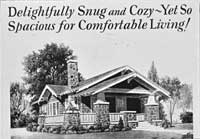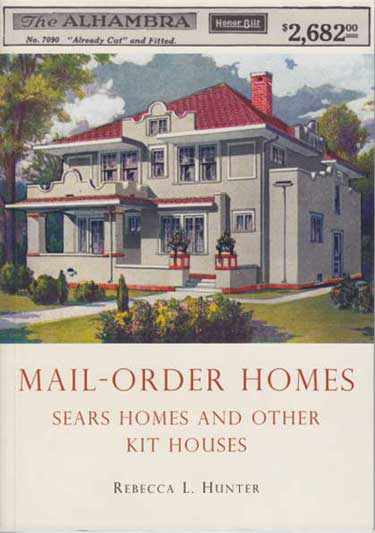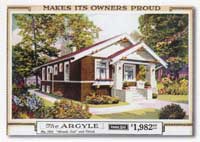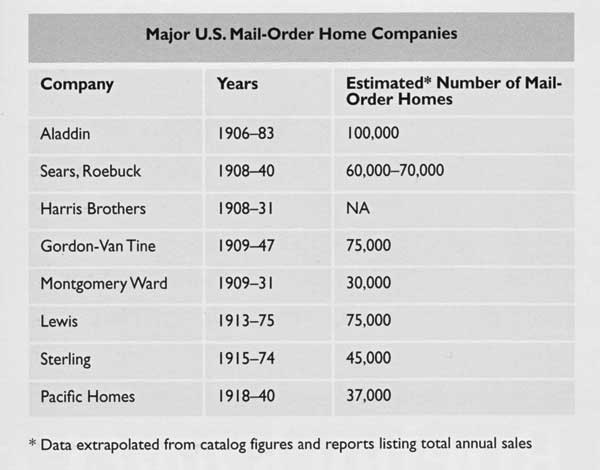Small Home Gazette, Summer 2013
Mail-Order Homes: Sears Homes and Other Kit Houses
Book Review
 If you’ve been a Bungalow Club member for at least seven years, you may have attended a popular presentation we held in November of 2005. Old-house researcher Rebecca L. Hunter traveled to Minnesota and spent a long day combing Twin Cities neighborhoods in search of the elusive mail-order house. I was her chauffeur and marveled at her encyclopedic knowledge of not only Sears and Roebuck kit homes, but also models built by seven or eight competing companies of the day. She brought with her a stack of three-ring binders stuffed with photocopies of kit home catalogs scribbled with notes. But she mostly relied on memory, expertly scanning both sides of the scores of streets we drove down that day. Occasionally she’d say something like, “Stop. That might be a Walton.”
If you’ve been a Bungalow Club member for at least seven years, you may have attended a popular presentation we held in November of 2005. Old-house researcher Rebecca L. Hunter traveled to Minnesota and spent a long day combing Twin Cities neighborhoods in search of the elusive mail-order house. I was her chauffeur and marveled at her encyclopedic knowledge of not only Sears and Roebuck kit homes, but also models built by seven or eight competing companies of the day. She brought with her a stack of three-ring binders stuffed with photocopies of kit home catalogs scribbled with notes. But she mostly relied on memory, expertly scanning both sides of the scores of streets we drove down that day. Occasionally she’d say something like, “Stop. That might be a Walton.”
 At her presentation for the Bungalow Club that evening, many of us were disappointed to learn that there simply aren’t that many kit homes in the Twin Cities. Rebecca explained that early 20th century cities with strong building trade unions, developers and architects, effectively froze out most kit homes, promoting local design, labor and materials as superior.
At her presentation for the Bungalow Club that evening, many of us were disappointed to learn that there simply aren’t that many kit homes in the Twin Cities. Rebecca explained that early 20th century cities with strong building trade unions, developers and architects, effectively froze out most kit homes, promoting local design, labor and materials as superior.
Still, the concept of a mail-order home seems to hold an allure for us bungalow dwellers. The thought of an entire house in thousands of pieces—precut lumber, doors and windows, light fixtures, door hardware, shingles, paint, nails—arriving at the building site ready for assembly, is just too cool. They’re the grownup versions of Lincoln Logs, dollhouses and model train sets.
Even if most of us aren’t lucky enough to live in a certified kit home, we can indulge our domicile fantasies for just $9.95 (or less online) by purchasing a copy of Hunter’s new book, Mail-Order Homes: Sears Homes and Other Kit Houses. It’s a small-format softcover of only 64 pages, but it’s packed with well-organized information, images gleaned from vintage catalogs, and photos of still-standing kit homes.
 Hunter writes well, in easy-to-digest chunks of text separated by frequent section headings. Plentiful images and illustrations are accompanied by informative captions. She also keeps things interesting by quoting owners of kit homes, both original and current, and by including tidbits such as the homes’ prices, colorful advertising copy, and assorted trivia.
Hunter writes well, in easy-to-digest chunks of text separated by frequent section headings. Plentiful images and illustrations are accompanied by informative captions. She also keeps things interesting by quoting owners of kit homes, both original and current, and by including tidbits such as the homes’ prices, colorful advertising copy, and assorted trivia.
The book begins with an explanation of the evolution of the mail-order concept, then covers the major manufacturers of kit homes, some of which sold even more homes than Sears. Hunter provides an overview of the primary styles and designs that were offered (bungalows were one of many), and describes how they were marketed and the type of buyer who was targeted in advertising. She wraps up by describing the demise of the mail-order home, which surprisingly didn’t occur until the early 1980s.

And yes, there are a couple of pages devoted to identifying a mail-order home, in case you still cling to the hope that yours is one.
For the price, Mail-Order Homes: Sears Homes and Other Kit Houses is a fast, fun, fascinating read about an important element of the bungalow era.











